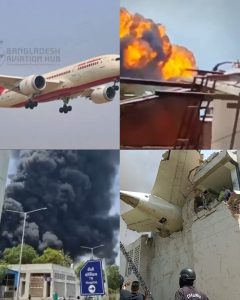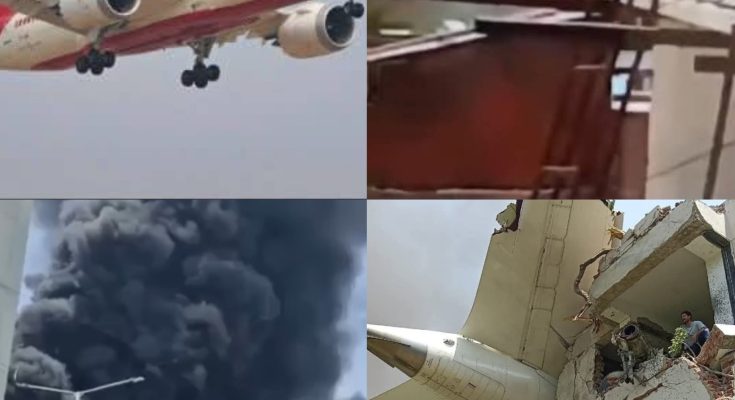#AI171 crash / There were 242 people on-board (including 12 crew) the Boeing 787-8 #Dreamliner (VT-ANB) Air India that crashed earlier today, June 12th, just seconds after take-off from Ahmedabad.

Air India B787 Aircraft VT-ANB, while operating flight AI-171 from Ahmedabad to Gatwick crashed immediately after take-off from Ahmedabad. There were 242 people on board the aircraft, consisting of 2 pilots and 10 cabin crew. In a recent post on ‘X’, Air India revealed the details of the passengers on board the Boeing 787-8 aircraft. The Boeing 787-8 flight departed from Ahmedabad at 13:38 hrs with 242 passengers and crew on board. Among them were 169 Indian nationals, 53 British nationals, 1 Canadian, and 7 Portuguese nationals. In the wake of the tragic situation, Air India have also set up a dedicated passenger hotline number 1800 5691 444 to provide further informations.
According to authorities, the flight included 169 Indian nationals, 53 British nationals, one Canadian, and seven Portuguese nationals. The aircraft departed from Runway 23 of Sardar Vallabhbhai Patel International Airport, Ahmedabad, at 1:39 PM IST, and issued a ‘MAYDAY’ distress call soon after. It then lost contact with Air Traffic Control (ATC). As per the Directorate General of Civil Aviation (DGCA), the plane crashed just outside the Ahmedabad airport perimeter, with thick black smoke reported at the crash site. The pilot in command, Captain Sumit Sabharwal, had over 8,200 hours of flying experience. The co-pilot had clocked in around 1,100 hours. Air India confirmed the incident in a public statement, noting that updates would be shared via its official website and social media channels.
**Tragedy in Ahmedabad: Air India Flight AI171 Crashes Moments After Takeoff**
A devastating tragedy unfolded today, June 12th, shortly after Air India flight AI171 departed from Ahmedabad. The Boeing 787-8 Dreamliner, registration VT-ANB, carrying 242 people – 230 passengers and 12 crew members – crashed just seconds after lifting off from the runway. The incident represents a profound and sudden loss of life, sending shockwaves across the nation and the global aviation community.
Initial reports indicate the crash occurred almost immediately after the aircraft became airborne, a critical and highly dynamic phase of flight. The precise circumstances surrounding the failure remain unclear in the immediate aftermath. Emergency services were reportedly on the scene rapidly, but the nature of a high-speed crash just after takeoff presents immense challenges for rescue and recovery operations. The scene is described as one of devastation, reflecting the powerful forces involved in the disaster.
The aircraft involved, the Boeing 787-8 Dreamliner, is a modern wide-body jet lauded for its technological advancements, fuel efficiency, and passenger experience. Introduced in the early 2010s, the Dreamliner is a staple in the long-haul fleets of many major airlines, including Air India. While the type has experienced technical issues throughout its operational history – particularly in its early years – it is generally considered a safe and sophisticated aircraft when properly maintained and operated. Air India, as India’s flag carrier, operates a substantial fleet and adheres to international aviation safety standards set by regulatory bodies.
Attention now shifts immediately to the complex process of air crash investigation. India’s Directorate General of Civil Aviation (DGCA) will lead the inquiry, likely with support from international agencies and technical expertise from Boeing. The primary objective of such an investigation is to determine the root cause of the accident – whether it was mechanical failure, human error, environmental factors, or a combination thereof – solely to enhance aviation safety and prevent future occurrences. Critical to this process will be the recovery and analysis of the Flight Data Recorder (FDR) and Cockpit Voice Recorder (CVR), commonly known as the ‘black boxes’, which hold vital information about the aircraft’s performance and crew actions in the final moments.
Beyond the technical investigation, the human toll of this tragedy is immense. Each of the 242 individuals on board represents a life, a family, a network of friends and colleagues. The suddenness of the disaster multiplies the grief and shock felt by loved ones. Air India and relevant authorities are expected to establish family assistance centers to provide support, information, and humanitarian aid to those affected. The emotional and psychological impact on the families, first responders, and the wider community in Ahmedabad is profound and will require significant support in the weeks and months ahead.
As the investigation commences and recovery efforts continue, the focus remains on supporting the families of the victims and understanding the sequence of events that led to this catastrophic loss. The loss of Air India flight AI171 is a stark reminder of the inherent risks in aviation, even with advanced technology and stringent safety protocols. The world watches and waits for answers, standing in solidarity with all those impacted by this devastating incident.


